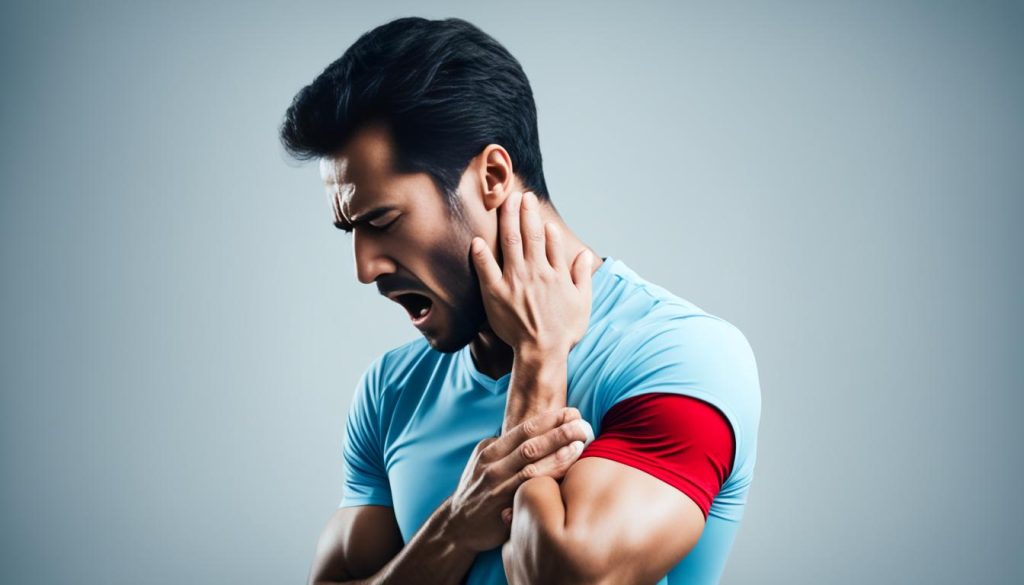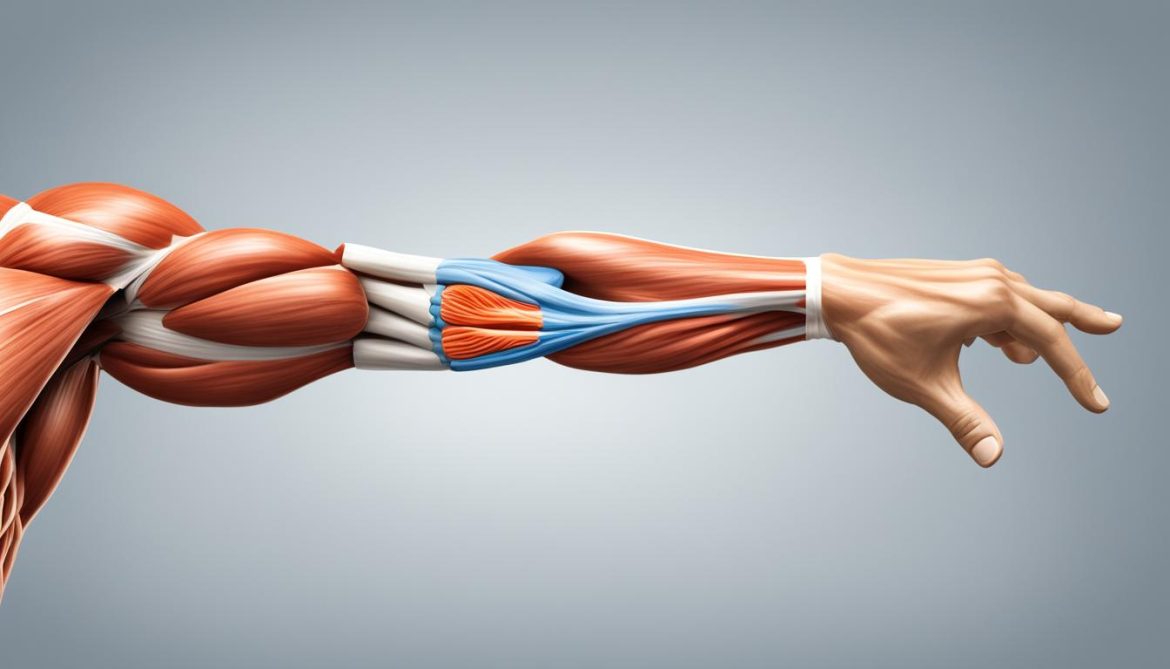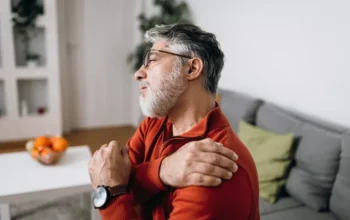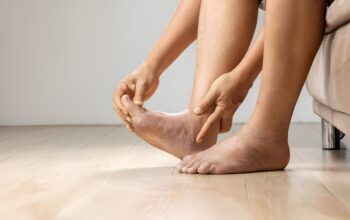Sneezing is a common bodily reflex that is usually harmless. However, for some individuals, sneezing can cause pain in their arms. In most cases, this arm pain is not a cause for concern, but it’s important to understand the underlying reasons and when to seek medical help.
Arm pain when sneezing, also known as sneezing-induced arm pain, can be a perplexing and uncomfortable experience. It can range from a mild ache to sharp, shooting pain that radiates through the arm. Understanding why sneezing affects the arms can help you manage the discomfort and know when to seek professional advice.
Key Takeaways:
- While arm pain when sneezing is usually harmless, it’s important to understand the underlying causes and seek medical attention if the pain is severe or frequent.
- Sneezing-induced arm pain can be caused by muscle strain, pinched nerves, dislocated vertebrae, herniated discs, or other underlying conditions.
- Arm pain when sneezing is a temporary issue that typically resolves on its own, but if it persists or worsens, it’s important to consult a healthcare professional to rule out any serious underlying conditions.
- It is crucial to prioritize safety, especially when driving, as arm pain when sneezing can temporarily affect your ability to control a vehicle.
- If you experience arm pain when sneezing, try to relax your muscles and avoid any sudden movements that may exacerbate the discomfort.
Why Do We Sneeze?
Sneezing is a natural mechanism that the body uses to clear the nose of foreign objects like pollen, dirt, or dust. When these substances irritate the lining of the nose, the brain signals the body to sneeze in order to remove them.
Sneezing involves the contraction of muscles, the closing of the eyes, and the release of water, mucus, and air from the nose. It acts as a reset for the nasal environment and is generally a normal and harmless response.
During a sneeze, several internal actions take place simultaneously. The diaphragm contracts, pushing air upward, while the muscles involved in breathing, such as the intercostal muscles, relax to allow the air to flow out. The muscles in the throat contract to close the glottis, the opening between the vocal cords, to ensure that the air does not escape through the mouth. At the same time, the muscles around the eyes tighten, causing the eyelids to close.
This coordinated series of muscle contractions and relaxations results in a sudden and forceful expulsion of air from the lungs through the nose. Along with the air, water droplets, mucus, and any foreign particles present in the nasal passages are expelled.
The purpose of sneezing is to clear the nasal passages and protect the respiratory system. It helps remove irritants and prevent them from entering further into the respiratory system, potentially causing harm.
The Sneezing Reflex
The sneezing reflex is a complex process that starts with the irritation of the nasal lining. This irritation triggers a signal to the brain, which then initiates the sneezing response to expel the irritants from the nasal passages.
Once the irritants reach the nose, the nerve endings present in the nasal lining detect their presence. These nerve endings are highly sensitive and respond to various types of irritants, ranging from allergens, viruses, bacteria, and dust particles.
When the nerve endings detect the irritants, they send electrical signals to the brainstem, where the sneezing reflex is located. The brainstem then activates a series of motor responses to create the sneeze.
- The first action is the deep inhalation of air. This intake of breath allows the lungs to draw in a larger volume of air, necessary for the forceful expulsion during the sneeze.
- Next, the muscles involved in the sneezing reflex contract, including the diaphragm and the intercostal muscles. This increases the pressure in the chest cavity.
- Simultaneously, the muscles around the eyes contract, causing the eyelids to squeeze shut. This reflex protects the eyes from any potential harm during the forceful expulsion of air.
- Finally, the glottis, the opening between the vocal cords, closes tightly to direct the expelled air and irritants out through the nose. This ensures that the air does not escape through the mouth and that the expelled particles are effectively cleared from the nasal passages.
The entire sneezing process happens quickly, usually taking less than a second. After a sneeze, the nasal passages are cleared, and the respiratory system is protected from the irritants that triggered the sneezing reflex.
It is important to note that sneezing can occur in response to various factors, including nasal irritants, allergies, colds, and even bright lights. Sneezing is a natural and necessary bodily function that helps keep our respiratory system clean and free from potential harm.
Types of Pain After Sneezing
After sneezing, some individuals may experience various types of pain in different parts of their arms. Understanding these types of pain can help identify potential underlying causes and guide appropriate treatment. Common types of pain after sneezing include:
Pain in the Entire Arm
Some people may feel pain that radiates throughout their entire arm after sneezing. This pain can range from mild to severe and may be accompanied by a tingling sensation or numbness. The exact cause of this type of pain may be related to muscle and bone movement during sneezing or underlying conditions such as pinched nerves.
Elbow Numbness and Pain
Others may experience tingling and pain specifically in the elbow area after sneezing. This type of pain can be sharp or throbbing and may be due to nerve compression or irritation caused by the sneeze. It’s important to pay attention to any associated symptoms, such as weakness or difficulty in moving the arm.
Shoulder Pain
Sneezing can also trigger pain in the shoulder for some individuals. This can be a result of the sudden and forceful movement during a sneeze, which can strain the muscles and joints in the shoulder area. It’s essential to differentiate between general muscle soreness and persistent or severe shoulder pain that may require further medical evaluation.
If you experience any of these types of pain after sneezing, it’s important to monitor for any additional symptoms or patterns. Seek medical advice if the pain is severe, prolonged, or accompanied by other concerning symptoms. A healthcare professional can provide a proper diagnosis and recommend appropriate treatment options.
| Pain Type | Possible Causes |
|---|---|
| Pain in the Entire Arm | Muscle and bone movement during sneezing Pinched nerves or nerve compression |
| Elbow Numbness and Pain | Nerve compression or irritation Muscle strain |
| Shoulder Pain | Muscle and joint strain Sudden and forceful movement during sneezing |
Remember, it’s always important to consult with a healthcare professional for a proper evaluation and diagnosis if you experience persistent or severe pain after sneezing.
Causes of Arm Pain After Sneezing
Arm pain after sneezing can be attributed to various factors involving the spine and muscles. When the nerves connecting to the arms are affected, conditions like pinched nerves, dislocated vertebrae, or herniated discs can all contribute to arm pain. Additionally, muscle strain can also result in discomfort and pain after sneezing. In rare cases, sneezing alone can even lead to vertebral compression fractures, particularly in individuals with thin bones or osteoporosis.
Pinched nerves occur when excessive pressure is applied to a nerve by surrounding tissues, such as bones, cartilage, muscles, or tendons. This compression can cause arm pain, tingling sensations, weakness, or numbness.
Dislocated vertebrae refer to a misalignment of the vertebral bones in the spine. This displacement can occur due to trauma, injury, or degenerative conditions, leading to arm pain as the nerves in the affected area become compressed or irritated.
Herniated discs, also known as slipped discs or ruptured discs, occur when the gel-like material inside a spinal disc protrudes through the disc’s outer layer. This protrusion can put pressure on the nearby nerves, resulting in arm pain or other related symptoms.
Muscle strain happens when the muscles and tendons in the arm experience excessive stretching or tearing, usually due to an injury or overuse. Sneezing can exacerbate the strain, causing arm pain and discomfort.
In rare instances, sneezing alone can cause vertebral compression fractures. These fractures occur when the vertebrae in the spine collapse or become compressed. Sneezing can exert sudden force on the spine, particularly in individuals with weakened bones, leading to fractures and subsequent arm pain.
Understanding the underlying causes of arm pain after sneezing is essential for accurate diagnosis and appropriate treatment. If you experience persistent or severe arm pain after sneezing, it is recommended to consult a healthcare professional for a comprehensive evaluation and guidance.
| Cause | Description |
|---|---|
| Pinched Nerves | Excessive pressure on nerves from surrounding tissues |
| Dislocated Vertebrae | Misalignment of vertebral bones in the spine |
| Herniated Discs | Protrusion of gel-like material from spinal discs |
| Muscle Strain | Excessive stretching or tearing of arm muscles and tendons |
| Vertebral Compression Fractures | Collapsed or compressed vertebrae due to sneezing |
Dangers of Arm Pain When Sneezing
While experiencing arm pain when sneezing may not typically be a cause for alarm, it is important to be aware of potential risks associated with this discomfort. One significant concern is the potential loss of control of a vehicle if the pain occurs while driving.
The sudden and intense pain caused by sneezing can momentarily disrupt sensory and control abilities, compromising your ability to safely operate a vehicle. Although this scenario is rare, it is crucial to prioritize safety and take appropriate measures to manage and treat arm pain after sneezing.
It is advisable to seek medical attention if you frequently experience sustained arm pain after sneezing. Consulting with a healthcare professional can help identify any underlying conditions that may be contributing to the discomfort and help develop an appropriate treatment plan.
Remember, your safety and the safety of others on the road should always be a top priority. Proper diagnosis, management, and treatment of arm pain when sneezing can help minimize potential risks and ensure a safe driving experience.

| Dangers of Arm Pain When Sneezing |
|---|
| Potential loss of control of a vehicle while driving |
| Momentary disruption of sensory and control abilities |
| Risk of impaired driving due to intense pain |
Conclusion
Arm pain when sneezing is a relatively common and typically harmless occurrence. The sudden force and movement associated with sneezing can lead to temporary discomfort in the arms. In most cases, this pain does not require any specific treatment and will often subside on its own.
However, if the arm pain when sneezing is severe, frequent, or accompanied by other symptoms, it is important to seek medical advice. Understanding the underlying causes of the pain, such as pinched nerves or muscle strain, can help guide appropriate treatment and management strategies.
It is also important to prioritize safety, especially when driving. While rare, the momentary loss of control caused by arm pain during sneezing can pose risks on the road. Taking steps to prevent and manage arm pain when sneezing, such as maintaining good posture and strengthening the muscles surrounding the spine, can help minimize discomfort and reduce the potential for accidents.
FAQ
Why do my arms hurt when I sneeze?
Sneezing can cause pain in the arms for some individuals. This arm pain is usually not a cause for concern and is often a result of the sudden force and movement associated with sneezing.
What is the mechanism behind sneezing?
Sneezing is a natural reflex that helps clear the nose of foreign objects like pollen, dirt, or dust. The brain signals the body to sneeze when the lining of the nose is irritated, resulting in the contraction of muscles, closing of the eyes, and the release of water, mucus, and air from the nose.
What types of pain can occur after sneezing?
After sneezing, some people may experience pain in the entire arm, numbness and pain in the elbow, or pain in the shoulder. The intensity and duration of the pain can vary.
What are the causes of arm pain after sneezing?
Arm pain after sneezing can be caused by factors such as pinched nerves, dislocated vertebrae, herniated discs, muscle strain, or vertebral compression fractures. Understanding these underlying causes can help in proper diagnosis and treatment.
Are there any dangers associated with arm pain when sneezing?
While arm pain when sneezing is generally not a cause for alarm, there is a potential risk of temporary loss of control of a vehicle if the pain occurs while driving. However, this is rare. It is important to prioritize safety and seek proper treatment for frequent and sustained arm pain after sneezing.
What should I do if I experience arm pain when sneezing?
If the arm pain is severe, frequent, or accompanied by other symptoms, it is important to seek medical advice. Remember to prioritize safety, especially when driving, and take steps to prevent and manage arm pain during sneezing.







